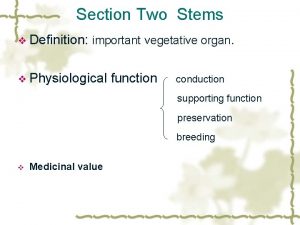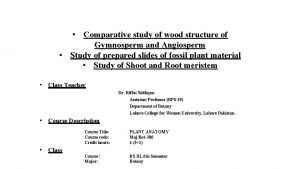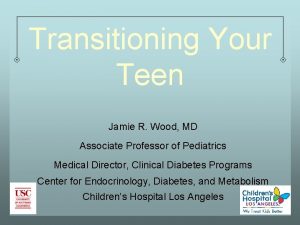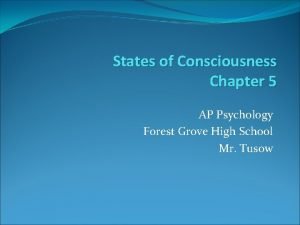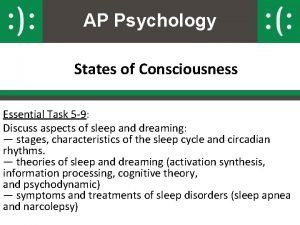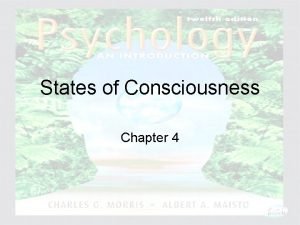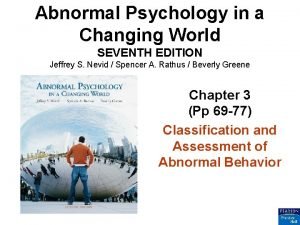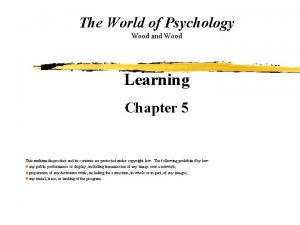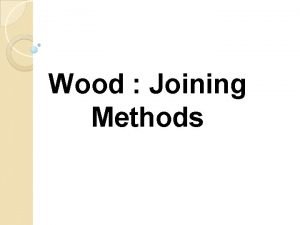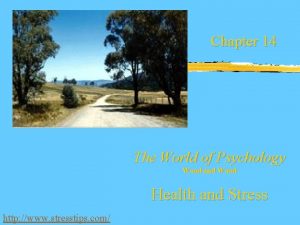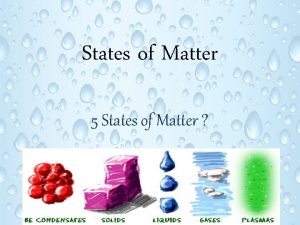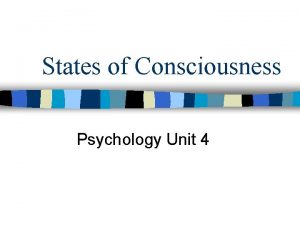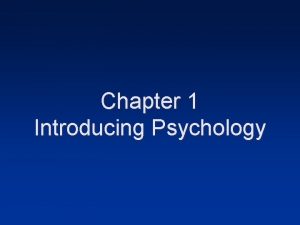The World of Psychology Wood Wood States of










































































- Slides: 74

The World of Psychology Wood & Wood States of Consciousness Chapter 4 This multimedia product and its contents are protected under copyright law. The following prohibited by law: n any public performance or display, including transmission of any image over a network; n preparation of any derivative work, including the extraction, in whole or in part, of any images; n any rental, lease, or lending of the program

Consciousness Copyright © Allyn & Bacon 2002

Circadian Rhythms n n Suprachiasmatic Nucleus Jet Lag Shift Work Taking Melatonin

Circadian Rhythms x. All eukaryotes and some prokaryotes (cyanobacteria) display changes in gene activity, biochemistry, physiology, and behavior that wax and wane through the cycle of days and nights. x. The level of the hormone melatonin that rises during the night and falls during the day. x. When the organism is placed in constant conditions these rhythms persist. y. However, without environmental cues, they tend to be somewhat longer or somewhat shorter than 24 hours ygiving rise to the name circadian rhythms (L. circa = about; dies = day). Copyright © Allyn & Bacon 2002

The Circadian Clock in Mammals x. A low level description: Copyright © Allyn & Bacon 2002

Suprachiasmatic Nucleus: x. A discreet brain region lying within the hypothalamus x. Responsible for the generation of circadian oscillations. Copyright © Allyn & Bacon 2002

What is a Biorhythm? A biorhythm is based on the idea that certain aspects of your life move in cycles. Physical, Emotional, Intellectual, and Intuitive well being. The cycle is based on a sine wave, each starting at 0 on the day of your birth. Physical cycles once every 23 days Emotional cycles once every 28 days Intellectual cycles once every 33 days Intuitive cycles once every 38 days Biorhythm cycles are expressed as a percentage from -100% to 100%. Copyright © Allyn & Bacon 2002

Jet Lag x. Suppose you fly from Chicago to London, and the plane lands at 12: 00 midnight Chicago time, about the time you usually go to sleep. x. At the same time that it is midnight in Chicago, it is 6: 00 A. M. in London, almost time to get up. x. The clocks, the sun, and everything else in London tell you it is early morning, but you still feel like it is 12: 00 midnight. x. You are experiencing jet lag. Copyright © Allyn & Bacon 2002

Jet Lag 2 x. The problem is not simply the result of losing a night’s sleep. x. You are fighting your own biological clock, which is synchronized with your usual time zone and not the time zone you are visiting. x. It is difficult to try to sleep when your biological clock is telling you to wake up and feel alert. x. It is even harder to remain awake and alert when your internal clock is telling you to sleep. x. Jet lag is less troublesome for women, younger people, extroverts, and night owls (Kiester, 1997). Copyright © Allyn & Bacon 2002

Shift Work – How many & Who x About 20% of Americans work at night and sleep during the day (Slon, 1997). x The health care, data-processing, and transportation industries are the largest employers of shift workers. Copyright © Allyn & Bacon 2002

Shift Work – Problems x. Shift workers complain of sleepiness and sleeping difficulties. x. Shift workers average 2 to 4 hours less sleep than nonshift workers of the same age (Campbell, 1995). x. From 75% to 90% of workers complain of sleepiness during the night shift, and many actually fall asleep during their shift (Leger, 1994). Copyright © Allyn & Bacon 2002

Shift Work – Problems x. Alertness and performance deteriorate if people work during subjective night, when their biological clock is telling them to go to sleep (Åkerstedt, 1990; Folkard, 1990). x. During subjective night, energy and efficiency are at their lowest point, reaction time is slowest, productivity is diminished, and industrial accidents are significantly higher. Copyright © Allyn & Bacon 2002

Shift Work – Problems x. More errors in judgment and most accidents occur during the night shift. y Three Mile Island, y Chernobyl y Challenger disaster (Moore-Ede, 1993). x. Even the slight circadian disruption due to daylight saving time is associated with yan increase in traffic accidents y a short-term but significant 6. 5% increase in accidental deaths (Coren, 1996 a, 1996 b). Copyright © Allyn & Bacon 2002

Making shift rotation less disruptive x. Rotating work schedules forward from days to evenings to nights makes adjustment easier ybecause people find it easier to go to bed later and wake up later than the reverse. x. Changing workers’ shifts every three weeks rather than every week has also improved yjob satisfaction, yhealth, yproductivity (Czeisler et al. , 1982). x 12 -hour shifts provide more time off and improve night-shift workers’ family and social lives (Moore-Ede, 1993). Copyright © Allyn & Bacon 2002

Making shift rotation less disruptive more ideas… x. Exposure to appropriately timed bright light or even light of medium intensity has been found to reset the biological clocks of young adults (Campbell, 1995; Eastman et al. , 1995; Martin & Eastman, 1998). x. Some researchers have helped shift workers reset their biological clocks by having them take melatonin supplements at specifically determined times. ACTIVITY Copyright © Allyn & Bacon 2002

Taking Melatonin x. Melatonin yhas not been approved by the FDA as a drug, y is sold over the counter as a sleep aid or dietary supplement. x. Taking melatonin helps yreset the biological clock in night-shift workers y reset the biological clock in those suffering from jet lag. x. Low doses (0. 3– 1. 0 milligram) taken several hours before bedtime have been found to ypromote sleep in healthy young males ywithout significantly altering the structure of sleep ywithout creating negative aftereffects the following Copyright © Allyn & Bacon 2002 morning (Zhdanova et al. , 1996).

Taking Melatonin x Another view of the Hype: x Other issues: y. Effects the immune system y. Contraindicated in x Arthritis x Lupus x Autoimmune conditions y. Believed by some to lengthen lifespan y. Replaces decrease in age related levels Copyright © Allyn & Bacon 2002

Lecture 4 a n Sleep NREM and REM Sleep n n n Sleep Cycles Variations in Sleep The Functions of Sleep Deprivation Dreaming

NREM and REM Sleep Copyright © Allyn & Bacon 2002

NREM Sleep: x. NREM sleep is sleep in which there are no rapid eye movements. x. NREM moves from Light to Deep Sleep in Stages x. Stages have smooth transitions xcalled “quiet sleep, ” because y heart rate and respiration are slow and regular, y there is little body movement y blood pressure and brain activity are at their lowest points of the 24 -hour period. Copyright © Allyn & Bacon 2002

REM Sleep : Rapid Eye Movements and Dreams x. REM sleep, sometimes called “active sleep, ” y anything but calm, y constitutes 20– 25% of a normal night’s sleep in adults. y associated with intense brain activity. x. In fact, within 1 to 2 minutes after REM sleep begins, brain metabolism increases and brain temperature rises rapidly (Krueger & Takahashi, 1997). x. The body reacts as if to a daytime emergency. Epinephrine (adrenaline) shoots into the system, blood pressure rises, and heart rate and respiration become faster and irregular. y Ulcer patients may secrete 3 to 20 times as much stomach acid as during the day and may awaken with Copyright © Allyn & Bacon 2002 stomach pains (Webb, 1975).

REM Sleep : Rapid Eye Movements and Dreams x. In contrast to storm of internal activity, there is: y an external calm during REM sleep. y The large muscles of the body—arms, legs, trunk— become paralyzed (Chase & Morales, 1990). y Some researchers suggest that this paralysis prevents people from acting out their dreams. x A rare condition REM sleep behavior disorder y individuals are not paralyzed during REM sleep. y while dreaming, they may become violent, causing injury to themselves and their bed partners and damage to their homes (Broughton & Shimizu, 1995; Moldofsky et al. , 1995). Copyright © Allyn & Bacon 2002

Sleep Cycles x Sleepers progress through four NREM stages y The brain-wave pattern change from x Stages 1 and 2: faster, low-voltage waves To x Stages 3 and 4: slower, larger delta waves y Notice that the brain-wave activity during REM sleep is similar to that of the subject when awake. Copyright © Allyn & Bacon 2002

Brain Wave Patterns during Normal Sleep

Normal Sleep x Sleep follows a fairly predictable pattern x We all sleep in cycles. x Each cycle lasts about 90 minutes y a person has one or more stages of NREM sleep y followed by a period of REM sleep Copyright © Allyn & Bacon 2002

Variations in Sleep x The Older We Get, the Less We Sleep x Larks and Owls y Early to Rise y Late to Bed y. About 25% of people are larks: body temperature rises rapidly after they awaken and stays high until about 7: 30 P. M. Larks turn in early and have the fewest sleep problems. y About 25% of people are owls: body temperature of an owl gradually rises throughout the day, peaking in the afternoon and not dropping until later in the evening. Copyrightsomewhere © Allyn & Bacon 2002 y About 50% who are in between.

The Functions of Sleep x. The Restorative Theory Being awake produces wear and tear on the body and the brain, and sleep serves the function of restoring body and mind (Gökcebayet al. , 1994). x. Circadian Theory Sleepiness and alertness ebb and flow according to circadian rhythms. The circadian theory of sleep is based on the premise that sleep evolved to keep humans out of harm’s way during the dark of night and possibly from becoming prey for some nocturnal predator. Copyright © Allyn & Bacon 2002

The Functions of Sleep A Blended Theory x. Alexander Borbely (1984; Borbely et al. , 1989) x. Blends the circadian and restorative theories. y Feeling sleepy at certain times of day is consistent with the circadian theory. y That sleepiness increases the longer a person is awake is consistent with the restorative theory. OR y The urge to sleep is partly a function of how long a person has been awake and partly a function of the time of day (Webb, 1995). Copyright © Allyn & Bacon 2002

Sleep Deprivation x. After missing two or three nights y difficulty concentrating y lapses in attention y general irritability. x. After 60 hours without sleep y some people even have minor hallucinations. x. Most people who stay awake for long periods of time y Have microsleeps y 2 - to 3 -second lapses from wakefulness into sleep. y You may have experienced a microsleep if you have ever caught yourself nodding off for a few Copyright © Allyn & Bacon 2002 seconds in class or on a long automobile trip.

Sleep Deprivation 2 x What suffers most from prolonged sleep loss is the motivation to sustain performance. x If a task is brief or interesting or demanding, you can do almost anything. x Sleep deprivation seriously impairs human functioning (Pilcher & Huffcutt, 1996). y Even partial sleep deprivation impairs ability to y attend to relevant environmental stimuli y process relevant environmental stimuli y Moreover, sleep deprivation has a negative impact on mood, alertness, and performance y Are there any other serious effects of sleep loss? Unfortunately, yes. Partial sleep loss, even for one night, can significantly reduce the effectiveness of the human immune system by lowering killer cell activity. Copyright © Allyn & Bacon 2002

Sleep Deprivation 3 x Other serious effects of sleep loss Significantly reduce the effectiveness of the human immune system by lowering killer cell activity. Copyright © Allyn & Bacon 2002

Dreaming x Can occur during both NREM and REM sleep x Matches real world in time x We remember only a few x Features that stand out are bizarre or emotional. Copyright © Allyn & Bacon 2002

Dream Content Quiz Falling Being attacked or pursued Trying repeatedly to do something School, teachers, studying Sexual Arriving too late Eating Being frozen with fright Death of a loved person Flying Being locked up Finding money Swimming Snakes Being dressed inappropriately Being smothered Being nude in public Fire Failing an examination Seeing self as dead Copyright © Allyn & Bacon 2002

Dream Content Reported rates Falling (83%) Being attacked or pursued (77%) Trying repeatedly to do something (71%) School, teachers, studying (71%) Sexual experiences (66%) Arriving too late (64%) Eating (62%) Being frozen with fright (58%) Death of a loved person (57%) Flying (34%) Being locked up (56%) Finding money (56%) Swimming (52%) Snakes (49%) Being dressed inappropriately (46%) Being smothered (44%) Being nude in public (43%) Fire (41%) Failing an examination (39%) Seeing self as dead (33%) Copyright © Allyn & Bacon 2002

Dream Meaning x Symbols in dreams typically have two or more simultaneous meanings. These meanings change across persons and over time. Understanding the symbol in the context of the entire dream requires training, patience, Art, and the willingness to admit error. x Amusing site: http: //www. petrix. com/dreams/c. html x List similar to class exercise: http: //www. dreams. ca/nightmares. htm#Resolving x Caution! Digging around on the Internet for dream information will expose you to many cons, rip-offs, hucksters, weirdoes, well meaning idiots, the demented, and lies. Copyright © Allyn & Bacon 2002

Sleep Disorders n Sleepwalking and Sleep Terror n Nightmares n Sleep talking (Somniloquy) n Narcolepsy n Sleep Apnea n Insomnia

Sleepwalking and Sleep Terror x A sleep disturbance where a person partially awakens with a scream, dazed and groggy, in a panic state, with a racing heart. x Often runs in families. x Occurs during partial arousal from NREM Stage 4 sleep x Sleeper does not come to full consciousness. x Typically, no memory the following day. x Most cases begin in childhood x Attributed primarily to delayed development of the CNS. x Children usually outgrow the disturbance by adolescence. Copyright © Allyn & Bacon 2002

Nightmares x Very frightening dreams x Occur during REM sleep x Occur toward morning, when REM periods longest. x Likely to be remembered in vivid detail. x Most common themes are: y being chased, threatened, or attacked. x Can be a reaction to traumatic life experiences x More frequent during periods of: y high fevers, anxiety, emotional upheaval. x REM rebound during drug withdrawal or following long periods without sleep can also produce nightmares. Copyright © Allyn & Bacon 2002

Narcolepsy x. A Sudden Attack of REM Sleep x. An incurable sleep disorder characterized by y excessive daytime sleepiness y uncontrollable attacks of REM sleep y usually lasting 10 to 20 minutes x. People with narcolepsy— y number from 250, 000 to 350, 000 in the United States y have a drastically lowered quality of life y have more accidents virtually everywhere y are often stigmatized as lazy, depressed, and Copyright © Allyn & Bacon 2002 disinterested in work.

Narcolepsy 2 x. Anything that causes an ordinary person to be tired can trigger a sleep attack in a person with narcolepsy y a heavy meal y sunbathing at the beach y a boring lecture (NOT Psych 101 obviously!) x. A sleep attack can also be brought on by y laughter y an exciting situation (such as lovemaking) y a strongly emotion situation (such as anger or Copyright © Allyn & Bacon 2002 elation).

Narcolepsy 3 x. Narcolepsy is a physiological disorder caused by an abnormality in the part of the brain that regulates sleep. x. Has a strong genetic component x. Some dogs are subject to narcolepsy x. We have learned a lot by studying these dogs. Copyright © Allyn & Bacon 2002

Sleep Apnea Breathing Stops during Sleep x Over 1 million Americans—mostly obese men— x periods during sleep when breathing stops x the individual must awaken briefly to breathe x The major symptoms: y excessive daytime sleepiness y extremely loud snoring (as loud as a jackhammer), y often accompanied by snorts, gasps, and choking noises. Copyright © Allyn & Bacon 2002

Sleep Apnea Scenario x A person with sleep apnea will 1. 2. 3. 4. Repeat 5. 6. drop off to sleep stop breathing altogether awaken struggling for breath gasp several breaths in a semi-awakened state fall back to sleep stop breathing again x People with severe sleep apnea may partially awaken as many as 800 times a night to gasp for air. Copyright © Allyn & Bacon 2002

Sleep Apnea Aggravation & Sequela x. Contraindications: y Alcohol y Sedatives x. Severe sleep apnea can lead to: y chronic high blood pressure y heart problems y death Copyright © Allyn & Bacon 2002

Sleep Apnea Treatments x. Treatments for sleep apnea include y greatly reducing body weight (now considered crucial to any cure) y surgically modifying the upper airway x. Favored treatment, however y use of a continuous positive airway pressure device y delivers air through a mask y worn over the nose at night Copyright © Allyn & Bacon 2002

Insomnia x. Approximately one-third of adults in the United States suffer from insomnia xa sleep disorder characterized by difficulty falling or staying asleep, by waking too early, or by sleep that is light, restless, or of poor quality x can lead to distress and impairment in daytime xfunctioning Copyright © Allyn & Bacon 2002

Insomnia x. Transient (temporary) insomnia y lasts 3 weeks or less y Causes: x jet lag x emotional highs (an upcoming wedding) x emotional lows (losing a loved one or a job) x a brief illness or injury that interferes with sleep Copyright © Allyn & Bacon 2002

Chronic Insomnia x Much more serious than transient insomnia x lasts for months or even years x about 10% of the adult population x higher for women, the elderly, and people suffering x from psychiatric and medical disorders x may begin as a reaction to y a psychological problem y a medical problem x persists long after the problem is resolved. Copyright © Allyn & Bacon 2002

Chronic Insomnia Risks x Individuals with chronic insomnia experience 1. higher psychological distress 2. greater impairments of daytime functioning 3. are involved in more fatigue-related accidents, 4. take more sick leave, 5. use health care resources more often Copyright © Allyn & Bacon 2002

Altering Consciousness n Meditation n Hypnosis Myths n Medical uses n Sociocognitive Theory n Neodissociation n Dissociated Control n

Meditation (concentrative) Definition: x A group of techniques that involve x Focusing attention on y an object, ya word, yone’s breathing, ybody movement x to block out all distractions x to enhance well-being x to achieve an altered state of consciousness. Copyright © Allyn & Bacon 2002

Meditation Examples x yoga, Zen, and transcendental meditation (TM) xhave their roots in Eastern religions and are practiced by followers of those religions to attain a higher spiritual state. x. In the US these approaches are often used to yincrease relaxation yreduce arousal yexpand consciousness Copyright © Allyn & Bacon 2002

Meditation - yoga x In practicing yoga, a meditator typically assumes a cross-legged position known as the lotus and gazes at a visual stimulus —a mandala (a symbolic circular pattern) or an object such as a vase or a flower. Copyright © Allyn & Bacon 2002

Meditation - Zen x During Zen meditation, the individual counts breaths or concentrates on the breathing process. With all three approaches, the meditator’s goal is to block out unwanted thoughts and facilitate the meditative state. Herbert Benson (1975) suggests that any word or sound can be used for transcendental meditation. Moreover, he claims that the beneficial effects of meditation can be achieved through simple relaxation techniques. Do the Try It! to experience Benson’s relaxation response. Copyright © Allyn & Bacon 2002

Meditation - Transcendental Meditation™ In transcendental meditation, x. The meditator is given a mantra (a secret word assigned by a teacher) x. The meditator sits quietly with closed eyes x The meditator silently repeats the mantra over and over during meditation. Copyright © Allyn & Bacon 2002

Meditation – Common Features x. In all three approaches, the meditator’s goal is to y block out unwanted thoughts y facilitate the meditative state x. Herbert Benson (1975) suggests that: y any word or sound can be used for TM y the beneficial effects of meditation can be achieved through simple relaxation techniques. Copyright © Allyn & Bacon 2002

Meditation – Practice… Find a quiet place and sit in a comfortable position. 1. Close your eyes. 2. Relax all your muscles deeply. Begin with your feet and move slowly upward, relaxing the muscles in your legs, buttocks, abdomen, chest, shoulders, neck, and finally your face. Allow your whole body to remain in this deeply relaxed state. 3. Now concentrate on your breathing, and breathe in and out through your nose. Each time you breathe out, silently say the word ooommmm to yourself. 4. Repeat this process for 20 minutes. When you are finished, remain seated for a few minutes—first with your eyes closed, then with them open. Copyright © Allyn & Bacon 2002

Hypnosis x. Definition: xa procedure through which one person, the hypnotist, uses the power of suggestion to induce changes in thoughts, feelings, sensations, perceptions, or behavior in another person, the subject. Copyright © Allyn & Bacon 2002

Under Hypnosis x People suspend their usual rational and logical ways of thinking and perceiving and allow themselves to experience distortions in perceptions, memories, and thinking. x. They may experience positive hallucinations, in which they see, hear, touch, smell, or taste things that are not present in the environment. x. Or they may have negative hallucinations, in which they fail to perceive things that are actually present. Copyright © Allyn & Bacon 2002

Hypnosis How may & Who x About 80– 95% of people are hypnotizable to some degree, but only 5% can reach the deepest levels of the hypnotic state x The ability to become completely absorbed in imaginative activities is characteristic of highly hypnotizable people x Individuals’ fantasy-proneness and their expectation of responding to hypnotic suggestions were predictors of hypnotizability. Copyright © Allyn & Bacon 2002

Hypnosis Myths x. Hypnotized people are under the complete control of the hypnotist and will violate their moral values if told to do so. x. People can demonstrate superhuman strength and perform amazing feats under hypnosis. x. Memory is more accurate under hypnosis. x. People under hypnosis will reveal embarrassing secrets. x. People under hypnosis can relive an event as it occurred when they were children and can function mentally as if they were that age. Copyright © Allyn & Bacon 2002

Hypnosis Medical Uses xrecognized as a viable technique to be used in medicine, dentistry, and psychotherapy. xparticularly helpful in the control of pain (Hilgard, x It has also been used successfully to treat a wide range of disorders, including: ysevere morning sickness, y high blood pressure, y side effects of chemotherapy ybleeding, ypsoriasis, Copyright © Allyn & Bacon 2002

Hypnosis Medical Uses Other problems responding well to hypnosis are: x Asthma x Severe insomnia x Some phobias x Dissociative identity disorder Copyright © Allyn & Bacon 2002

Altered States of Consciousness Copyright © Allyn & Bacon 2002

Altered States of Consciousness n Drug Addition n Stimulants n Physical n Caffeine Dependence n Psychological Dependence n Nicotine n Amphetamines n Cocaine

Drug Use Copyright © Allyn & Bacon 2002

Depressants n Alcohol n Barbiturates n Minor Tranquilizers n Narcotics n Inhalants

Hallucinogens n Marijuana n LSD n MDMA (Ecstasy)

n n n Hallucinogens The hallucinogens, or psychedelics, are drugs that can alter and distort perceptions of time and space, alter mood, and produce feelings of unreality. Hallucinogens also cause hallucinations, sensations that have no basis in external reality Hallucinogens have been used in religious and recreational rituals and ceremonies in diverse cultures since ancient times

n n n Mescaline derivative from the mescal cactus used by some groups of Native Americans to produce hallucinations in their religious ceremonies. Other people have also used peyote, another mescal derivative, but typically only to get high.

n n Mary Jane marijuana tends to produce a feeling of well being, promote relaxation, lower inhibitions, and relieve anxiety. The user may experience an increased sensitivity to sights, sounds, and touch, as well as perceptual distortions and a perceived slowing of time.

n n n “Acid” LSD is lysergic acid diethylamide The average LSD “trip” lasts for 10 to 12 hours Usually produces extreme perceptual changes —visual hallucinations and distortions. Emotions can become very intense and unstable ranging from euphoria to anxiety, panic, depression, or even suicidal thoughts and actions LSD can cause bad trips that can be terrifying and leave the user in a state of panic. Can produce a flashback, a brief recurrence of a previous trip that occurs suddenly and

MDMA (Ecstasy) MDMA is a designer drug n n n a cross between a hallucinogen and an amphetamine. A hallucinogen-amphetamine – Oh BOY! The drug’s main appeal is its psychological effect—a feeling of relatedness and connectedness with others But animal experiments with MDMA have revealed some disturbing findings—irreversible destruction of serotonin releasing neurons MDMA is also more toxic than most other hallucinogens

Have YOU entered an Altered State of Consciousness? Let’s go home!
 What were the 11 free states
What were the 11 free states Southern states
Southern states Big states vs small states guard against tyranny
Big states vs small states guard against tyranny Fusiform rays
Fusiform rays Early and late wood difference
Early and late wood difference Angiosperm wood vs gymnosperm wood
Angiosperm wood vs gymnosperm wood Esau wood poem
Esau wood poem Wood wood teenager
Wood wood teenager States of consciousness ap psychology
States of consciousness ap psychology Altered state of consciousness psychology
Altered state of consciousness psychology Ap psychology states of consciousness
Ap psychology states of consciousness 7 states of consciousness
7 states of consciousness Revolutions and national states in the atlantic world
Revolutions and national states in the atlantic world Sudanic states ap world history
Sudanic states ap world history United states acquisitions and annexations 1857-1904
United states acquisitions and annexations 1857-1904 Ap art history
Ap art history Social forces states and world orders
Social forces states and world orders Hình ảnh bộ gõ cơ thể búng tay
Hình ảnh bộ gõ cơ thể búng tay Ng-html
Ng-html Bổ thể
Bổ thể Tỉ lệ cơ thể trẻ em
Tỉ lệ cơ thể trẻ em Chó sói
Chó sói Thang điểm glasgow
Thang điểm glasgow Chúa yêu trần thế alleluia
Chúa yêu trần thế alleluia Các môn thể thao bắt đầu bằng tiếng đua
Các môn thể thao bắt đầu bằng tiếng đua Thế nào là hệ số cao nhất
Thế nào là hệ số cao nhất Các châu lục và đại dương trên thế giới
Các châu lục và đại dương trên thế giới Công của trọng lực
Công của trọng lực Trời xanh đây là của chúng ta thể thơ
Trời xanh đây là của chúng ta thể thơ Mật thư anh em như thể tay chân
Mật thư anh em như thể tay chân 101012 bằng
101012 bằng Phản ứng thế ankan
Phản ứng thế ankan Các châu lục và đại dương trên thế giới
Các châu lục và đại dương trên thế giới Thể thơ truyền thống
Thể thơ truyền thống Quá trình desamine hóa có thể tạo ra
Quá trình desamine hóa có thể tạo ra Một số thể thơ truyền thống
Một số thể thơ truyền thống Cái miệng nó xinh thế chỉ nói điều hay thôi
Cái miệng nó xinh thế chỉ nói điều hay thôi Vẽ hình chiếu vuông góc của vật thể sau
Vẽ hình chiếu vuông góc của vật thể sau Nguyên nhân của sự mỏi cơ sinh 8
Nguyên nhân của sự mỏi cơ sinh 8 đặc điểm cơ thể của người tối cổ
đặc điểm cơ thể của người tối cổ V. c c
V. c c Vẽ hình chiếu đứng bằng cạnh của vật thể
Vẽ hình chiếu đứng bằng cạnh của vật thể Vẽ hình chiếu vuông góc của vật thể sau
Vẽ hình chiếu vuông góc của vật thể sau Thẻ vin
Thẻ vin đại từ thay thế
đại từ thay thế điện thế nghỉ
điện thế nghỉ Tư thế ngồi viết
Tư thế ngồi viết Diễn thế sinh thái là
Diễn thế sinh thái là Dot
Dot Các số nguyên tố
Các số nguyên tố Tư thế ngồi viết
Tư thế ngồi viết Lời thề hippocrates
Lời thề hippocrates Thiếu nhi thế giới liên hoan
Thiếu nhi thế giới liên hoan ưu thế lai là gì
ưu thế lai là gì Hổ đẻ mỗi lứa mấy con
Hổ đẻ mỗi lứa mấy con Khi nào hổ mẹ dạy hổ con săn mồi
Khi nào hổ mẹ dạy hổ con săn mồi Sơ đồ cơ thể người
Sơ đồ cơ thể người Từ ngữ thể hiện lòng nhân hậu
Từ ngữ thể hiện lòng nhân hậu Thế nào là mạng điện lắp đặt kiểu nổi
Thế nào là mạng điện lắp đặt kiểu nổi Positive psychology ap psychology definition
Positive psychology ap psychology definition Polarization psychology
Polarization psychology Social psychology ap psychology
Social psychology ap psychology Pure psychology
Pure psychology Social psychology definition psychology
Social psychology definition psychology Health psychology definition ap psychology
Health psychology definition ap psychology Abnormal psychology in a changing world
Abnormal psychology in a changing world Abnormal psychology in a changing world
Abnormal psychology in a changing world Old world monkeys vs new world monkeys
Old world monkeys vs new world monkeys Did pumpkins come from the new world or old world
Did pumpkins come from the new world or old world Real world vs digital world
Real world vs digital world The real world is the world of ideas
The real world is the world of ideas Ap world history chapter 25 africa and the atlantic world
Ap world history chapter 25 africa and the atlantic world The changing world output and world trade picture
The changing world output and world trade picture Countries michael jackson visited
Countries michael jackson visited What plots the map of the slum children
What plots the map of the slum children




